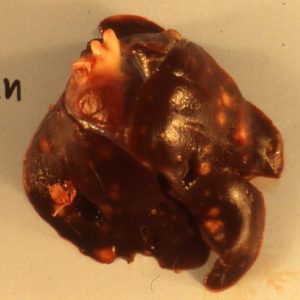Tuberculosis is an infectious, contagious disease common to humans and many animal species. Avian tuberculosis has become rare in industrial farming, mainly limited to little farms. On the other hand, it poses a public health problem because of the possible transmission of the disease from birds to humans.
The disease agent and its pathogenicity
Avian tuberculosis is usually caused by Mycobacterium avium, avian strain itself. It may also exceptionally be caused by the human strain M. tuberculosis, particularly in psittacids, or by the bovine strain M. bovis.
Mycobacteria are Gram positive bacteria (staining is difficult), immobile, uncapsulated and non-spore-forming bacillus. They have an acid-resistance property, revealed by the Ziehl-Neelsen stain.
Mycobacteria are sensitive to heat, light and desiccation. They are resistant to detergents and acids, but are sensitive to alcohol, iodine, formaldehyde and hypochlorites. They are also resistant to many common antibiotics. They can withstand several years in the soil.
The pathogenicity of M. avium depends on the host, and is due to the ability of the bacillus to multiply and to its ability to release virulence factors.
The infection of an animal results from a conjunction of a pathogenic strain, a minimal infecting dose, and repeated contacts. These periodic reinfections worsen the tuberculosis process. First, the bacillus multiplies at its entry point, without lesion or disorder; it is the occult tuberculosis, or latent tuberculosis. Then, if the infecting dose is sufficient and the environment is favourable, apparent tuberculosis develops: an inoculation canker is formed, corresponding to the primary infection lesion. Finally, in some cases, there is aggravation by dissemination of bacilli contained in lymphocytes and phagocytes, leading to various localizations of lesions.
In birds, this generalization leads to miliary tuberculosis.
Epidemiological data
Avian tuberculosis affects all avian species, wild or domestic. Cases of infection in mammals including humans are possible but rare; however, pigs are very sensitive to M. avium.
The sources are infected animals, even without symptoms. Bacillus excretion is early, long-lasting, intermittent and can be significant. All tissues and organs in a tuberculosis outbreak are virulent materials. The main ones are represented by faeces.
Transmission of the bacterium is mainly horizontal, either through direct contact with an infected individual or indirect contact through contaminated materials. The main route of penetration into the animal is the oral route, by coprophagy. Contamination requires repeated ingestion of doses to be effective.
It is an enzootically expressed disease that affects adult birds or birds over 6 months old. The high resistance of the agent makes it difficult to eliminate avian tuberculosis in a farm.
Clinical manifestations of the disease
The incubation period is long, 3 to 4 weeks or even several months. This explains the absence of the disease in industrial meat farming.
At the beginning of infection, the symptoms are not very characteristic: apathy, thinness despite a preserved appetite, atrophied pectoral muscles, pale or even yellow crest and barbels.
Then, local disorders appear, reflecting the localization of the process in different organs:
- Locomotor disorders: lameness without apparent damage (localization in the bone marrow), which may be complicated by arthritis or diffuse osteoperiostitis
- Skin and mucous membrane disorders, with wart-like granulations on the mucous membranes, and ulcero-necrotic nodules on the skin
- Digestive disorders with diarrhoea
- Genital disorders: cessation of egg laying
- Respiratory disorders
The disease progresses over several weeks or even months. It depends on the extent and severity of the injuries.
The characteristic lesions are mainly on the liver and spleen. They are also often found on the intestines and bone marrow. Sometimes lesions are found on the ovaries, oviducts, lungs and air sacs. These are granulomatous, yellowish-white, early cheeking nodules of the order of a few millimetres. On the intestines, there are “funnel” ulcers of the mucous membrane and on the peritoneum of the cluster nodules.

Le diagnostic
Laboratory diagnosis
- Histology : detection of the immunological granuloma and search for alcohol-acid-resistant bacilli in granulomas using Ziehl staining.
- Anecdotally, let us recall other techniques :
- Tuberculination : injection of 0.1 mL of avian tuberculin into a barbel, crest, caruncles, interdigital membrane, or neck skin, then reading of the inflammatory edematous reaction 1-2 days later.
- Serology by passive haemagglutination reaction.
Epidemioclinical diagnosis
- Contagious process of chronic evolution, especially in small farms, rather in old poultry
- Animals lose weight quickly, recurrent diarrhoea, lameness, cessation of egg laying
- Tuberculous granulomas on liver, spleen and intestine
Differential diagnosis
Lymphoid leucosis, Marek’s disease, aspergillosis, coligranulomatosis, histomonosis, salmonellosis, pseudo-tuberculosis.
Disease prevention and control
Avian tuberculosis cannot be treated for hygienic reasons. In the case of a diagnosis of avian tuberculosis, it is recommended to eliminate the animals, which results in the elimination of the main source of bacteria, to burn everything that can be burned, to clean and disinfect with an approved product and at the indicated dose, to treat the outside areas and surroundings, and to avoid reintroducing birds for several weeks, or even months if possible.
Prophylaxis is sanitary and hygienic.





